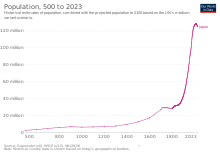
Back سكان اليابان Arabic Yaponiya əhalisi Azerbaijani Насельніцтва Японіі Byelorussian Население на Япония Bulgarian জাপানের জনপরিসংখ্যান Bengali/Bangla Demografie Japans German Demografía de Japón Spanish جمعیتشناسی ژاپن Persian Démographie du Japon French דמוגרפיה של יפן HE
| Demographics of Japan | |
|---|---|
 Population pyramid, 2021 | |
| Population | 123,990,000[1] (11th) |
| Growth rate | -0.7% (2020 est.) |
| Birth rate | 6.6 births/1,000 population (2023 est.) |
| Death rate | 11.7 deaths/1,000 population (2023 est.) |
| Life expectancy | 84.83 years |
| • male | 81 years |
| • female | 87 years |
| Fertility rate | |
| Infant mortality rate | 1.9 deaths/1,000 live births |
| Net migration rate | 0.74 migrant(s)/1,000 population |
| Age structure | |
| 0–14 years | |
| 15–64 years | |
| 65 and over | |
| Sex ratio | |
| Total | 0.95 male(s)/female (2022 est.) |
| At birth | 1.06 male(s)/female |
| Nationality | |
| Nationality | Japanese |
| Major ethnic | Japanese |


The demographics of Japan include Japanese population, birth and death rates, age distribution, population density, ethnicity, education level, healthcare system of the populace, economic status, religious affiliations, and other aspects regarding the population. According to the United Nations, the population of Japan was roughly 124.9 million people (as of January 2021), which peaked at 128.1 million people in 2010.[4] It the 6th-most populous country in Asia, and the 11th-most populous country in the world.
In 2023, the median age of Japanese people was projected to be 49.5 years, the highest level since 1950, compared to 29.5 for India, 38.8 for the United States and 39.8 for China. Japan has the second highest median age in the world (behind only Monaco). An improved quality of life and regular health checks are just two reasons why Japan has one of the highest life expectancies in the world.
The life expectancy from birth in Japan improved significantly after World War II, rising 20 years in the decade between 1945 and 1955. As life expectancy rises further, Japan expects to experience difficulties caring for the older generations in the future. Shortages in the service sector are already a major concern, with demand for nurses and care workers increasing.
The fertility rate among Japanese women was around 1.4 children per woman from 2010 to 2018. From then until 2022, the fertility rate further declined to 1.2. Apart from a small baby boom in the early 1970s, the crude birth rate in Japan has been declining since 1950; it reached its currently lowest point of 6.6 births per thousand people in 2023. With a falling birth rate and a large share of its inhabitants reaching old age, Japan's total population is expected to continue declining, a trend that has been seen since 2010.
Japanese is a major language of the Japonic language family spoken by Japanese people, which is separated into several dialects with the Tokyo dialect considered Standard Japanese. It has around 128 million speakers in total, primarily in Japan, the only country where it is the national language, and within the Japanese diaspora across the globe.
The sex ratio in Japan in 2021 was 95.38 males per 100 females. There are 61.53 million males and 64.52 million females in Japan. The percentage of female population is 51.18%, compared to 48.82% male population. Japan has 2.98 million more females than males.
| Year | Pop. | ±% |
|---|---|---|
| 1920 | 55,963,053 | — |
| 1925 | 59,736,822 | +6.7% |
| 1930 | 64,450,005 | +7.9% |
| 1935 | 69,254,148 | +7.5% |
| 1940 | 73,114,308 | +5.6% |
| 1945 | 71,998,104 | −1.5% |
| 1950 | 83,199,637 | +15.6% |
| 1955 | 89,275,529 | +7.3% |
| 1960 | 93,418,501 | +4.6% |
| 1965 | 98,274,961 | +5.2% |
| 1970 | 103,720,060 | +5.5% |
| 1975 | 111,939,643 | +7.9% |
| 1980 | 117,060,396 | +4.6% |
| 1985 | 121,048,923 | +3.4% |
| 1990 | 123,611,167 | +2.1% |
| 1995 | 125,570,246 | +1.6% |
| 2000 | 126,925,843 | +1.1% |
| 2005 | 127,767,994 | +0.7% |
| 2010 | 128,057,352 | +0.2% |
| 2015 | 127,094,745 | −0.8% |
| 2020 | 126,226,568 | −0.7% |
- ^ "Statistics Bureau Home Page/Population Estimates Monthly Report". www.stat.go.jp. Retrieved 20 February 2024.
- ^ "Japan demographic woes deepen as birthrate hits record low". Archived from the original on 2023-06-02. Retrieved 2023-06-02.
- ^ Clyde Haberman (1987-01-15). "Japan's Zodiac: '66 was a very odd year". The New York Times. Retrieved 2015-10-21.
- ^ "Statistics Bureau Home Page/Population Estimates Monthly Report". www.stat.go.jp. Retrieved 2024-03-03.
© MMXXIII Rich X Search. We shall prevail. All rights reserved. Rich X Search